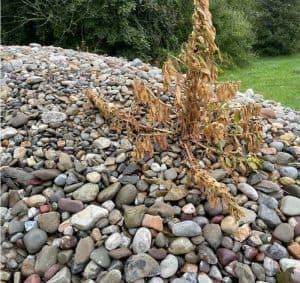Vegetation Management for Gravel Driveways and Lots
Maintaining a clean and well-kept stone lot or driveway is a challenging task. Weeds look messy and can attract insects and rodents. If left unchecked, the weeds will eventually take over the entire parking lot or driveway. In extreme cases, the stone may even be completely replaced by weeds.
To help keep your property safe and visually pleasing, we’ll explore effective techniques for vegetation management in gravel and stone lots and driveways.
Why do People put Gravel on Parking Lots?
For one, gravel is a cheaper material than concrete or asphalt. It’s also easier to install. Gravel driveways and parking lots last longer than you might think. With proper installation and maintenance, a stone driveway can last up to 20 years.
Another benefit of using this type of lot is that rain water won’t increase water runoff. However, a gravel driveway will require more maintenance.
Will Gravel Stop Weeds From Growing?
The answer is no. However, gravel can help control the spread of weeds. Use it to create a barrier that will make it difficult for them to spread. And stone dust helps gravel settle and pack down, preventing weeds from growing in stone areas where vehicles, equipment, materials, and inventory are stored.
Green Giant does a lot of vegetation management at lumber yards, manufacturing facilities, gravel parking lots, and driveways.
How to Kill Weeds in a Stone Lot
Weeds can quickly take over gravel driveways or parking lots if you don’t keep up with lot maintenance. These pesky plants make it difficult to keep the stone clean. When you let them grow, they eventually die and decompose. The decomposed weeds turn into soil, creating a seedbed for weeds to grow on top of the landscape fabric.
Here are some tips to help you maintain a gravel driveway or parking lot.
Step 1: Clear Out the Vegetation
After grading, the first step is to use weed killer to get rid of any vegetation before the gravel is spread. This will prevent weeds from growing, and (depending on the time of year) it could kill some of the seeds. Even though you’re killing the weeds, new ones will emerge in the stone within a few weeks, if you stop there.
If you get delayed and have weeds popping up, use weed killer to keep them at bay until you have time for step 2.
There are many brands of chemical weed killer available. Most often glyphosate is the product of choice. You can also use a pre-emergent product to help eliminate weed seeds. Pre-emergent herbicides stop these eyesores from growing by killing the seeds when they begin to germinate.
Always read the instructions on the weed killer container before using it. If you purchase a concentrated herbicide, make sure to carefully follow the mixing instructions on the label. Measure carefully. If you use too little, the weed killer might not work. And if you use too much, you’re wasting money.
Step 2: Put Down Landscape Fabric
Lay down landscape fabric before spreading the gravel. The weed killer you used in step one will only last until new seeds begin to grow. There are thousands of weed seeds in the soil, and the landscape fabric should keep them from growing.
Over time, the landscape fabric will deteriorate, so it’s not a bad idea to install two layers. You can also use plastic sheeting, but it’s not as durable. Landscape fabric and plastic sheeting can be purchased at most hardware stores.
Step 3: Find the Right Depth
The depth of gravel driveways depends on its intended purpose. For example, if you’re only parking cars, it doesn’t need to be as deep as a driveway used for RVs or other large vehicles. In general, gravel driveways should be at least six inches deep.
From a weed control standpoint, the deeper the better. The weeds growing in the 6-inch deep driveway will have a tough time getting to the water and nutrients they need, compared to the weeds in the 3-inch deep driveway. This additional stone can simply cause the roots to dry out, and the plants will die. Adding stone every few years will also be helpful.
Need help preventing weeds from overtaking your driveway or parking lot?
How Often Should I Spray Driveway or Parking Lot Weeds?
Most of our customers get two treatments a year. Once a year can be ok, as long as there isn’t much rain. The more rain we get, the more driveway weeds grow.
If you spray weed killer when the plants are small, you’ll have very little organic matter clogging up your stone, making it harder for weeds to grow.


How Not to Kill Weeds
- Don’t pull them by hand. It’s hard work, and the roots usually survive.
- Don’t use a flame weeder. We have not found them to be very effective, except on very small weeds.
- Don’t use weed-eaters. You want to kill driveway weeds completely, and weed eaters don’t kill the roots.

Can you Paint a Gravel Parking Lot?
A well-maintained gravel driveway or parking lot can be painted. However, the lines will need to be repainted on a regular basis.
For example, this well-maintained, clean parking lot has been spray painted for parking spaces. You can see where the painted lines are disappearing.

Regular maintenance is key to keeping weeds at bay and extending the life of your stone lot.
Green Giant is a member of the Lawn Care Association of Pennsylvania.
